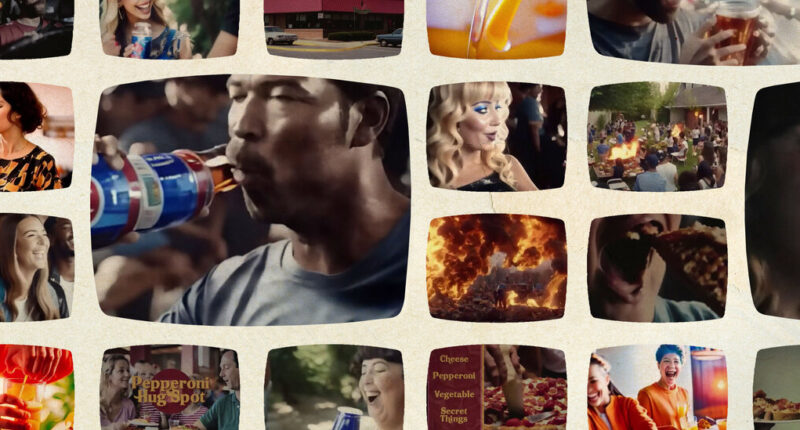
Some of the people who make commercials today are worried that A.I. could take their jobs, just as soon as it figures out how hands work. But asking A.I. to make fake ads gives it a job it already excels at: assistant ethnographer, media-studies expert, unbiased auditor of cultural tropes. This software, having slurped up the same commercial soup as the rest of us, takes a prompt like “family breakfast” or “outdoor party” and, based on the mass of examples on which it has been trained, calculates its way toward some probabilistic mean. It offers a composite picture of formulas and clichés — including those we’re usually too immersed in to notice.
Commercials, at this point, are America’s cave paintings.
In that orange-juice ad, for instance, we get a couple of shots of the classic juice pitcher — a wholly superfluous instrument whose purpose is to make us forget that the product is not freshly squeezed. Usually a few slices of citrus, floating elegantly inside, help sell that illusion. The A.I. has seen this fruit but cannot know why it’s there — and so the version it creates is a rogue foreign body, a cancerous green lump that starts to subsume the juice entirely. In “Synthetic Summer,” the partygoers seemingly don’t know how to drink: They hold cans a few inches from their faces or latch their lips to the sides. That’s probably because their real-life analogues hardly ever drink in commercials, either; it’s a convention of alcohol ads to show good times without explicitly depicting anyone taking a swig. This visual euphemism leaves a gap that A.I. struggles to bridge — and ends up filling with comical, unsettling imagery. This is one reason the A.I. commercials reward repeat viewing: Once you get past their grotesqueries, you start seeing fascinating signals buried in the noise.
Until the noise changes. One weakness of these tools is that by the time they’ve rounded up a genre’s common tropes, the genre may have moved on. “Synthetic Summer,” for instance, has the DNA of a 20-year-old Bud Light commercial; it bears little resemblance to the brand’s latest Super Bowl spot. For the moment, these are fever dreams of a recent past.
As far as brands are concerned, that’s fine: They need not train A.I. on ads from the glory days of linear television. In a fractured, polarized world, that kind of shared consensus may be obsolete. Companies seem a lot more likely to feed their A.I. furnaces with every available piece of data about potential customers — everything you’ve liked, bought or posted, every consumer demographic into which you might plausibly fit. The images and videos you see then may or may not be real, but they could easily feature the people and scenes that will most appeal to you or play most intimately on your insecurities. Which, when you think about it, could be a lot creepier than a few extra fingers.
Opening illustration: Screen grabs from YouTube.
Mac Schwerin is a copywriter and freelance journalist based in Washington.
Source: | This article originally belongs to Nytimes.com









